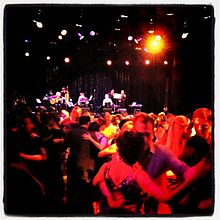- Milonga (place)
-
Milonga is a term for a place or an event where tango is danced. People who frequently go to milongas are sometimes called milongueros. The term "milonga" can also refer to a musical genre.
The music played is mainly tango, vals and milonga (as the musical genre). Most milongas are held on a regular basis (usually weekly), and they often begin with dancing classes and sometimes demonstration dances. Usually, three to five songs of a kind are played in a row (this is called tanda) followed by a short musical break (called cortina) to clear the dancefloor and facilitate partner changes. There are a number of informal rules that dictate how dancers should choose their dancing partners.[citation needed]
Due to the strict assembly ban imposed by the military government, milongas almost disappeared from Buenos Aires in the 1960s and 1970s[citation needed]. Nevertheless, since the beginning of the 1990s, the tango culture in Buenos Aires has undergone dynamic development, and today one can choose from between fifteen and thirty different milongas every day.
Well-known milongas
- Confitería Ideal: an old-fashioned milonga where dances are held afternoons and evenings, almost every day of the week. Confiteria Ideal was the setting for films like The Tango Lesson and Evita.
- Salon Canning: a meeting point for the best dancers of Buenos Aires on Fridays.
- La Nacional: another traditional milonga.
- Niño Bien: another traditional milonga.
- La Viruta: a preferred place for the younger public; up to 200 people attend dancing classes here before the dance. The music includes electrotango and sometimes even salsa and rock and roll.
- Cachirulo: One of the most traditional milongas in Buenos Aires requiring men and women to sit on opposite sides of the room. It takes place every Saturday from 6 pm to Sunday 4 am.
- La Catedral: an interesting milonga situated in an old factory. There are classes and milongas almost every night, with Tuesdays being a popular night for tourists and first-timers.
External links
Categories:- Tango
- Argentine culture
- Dance stubs
Wikimedia Foundation. 2010.

